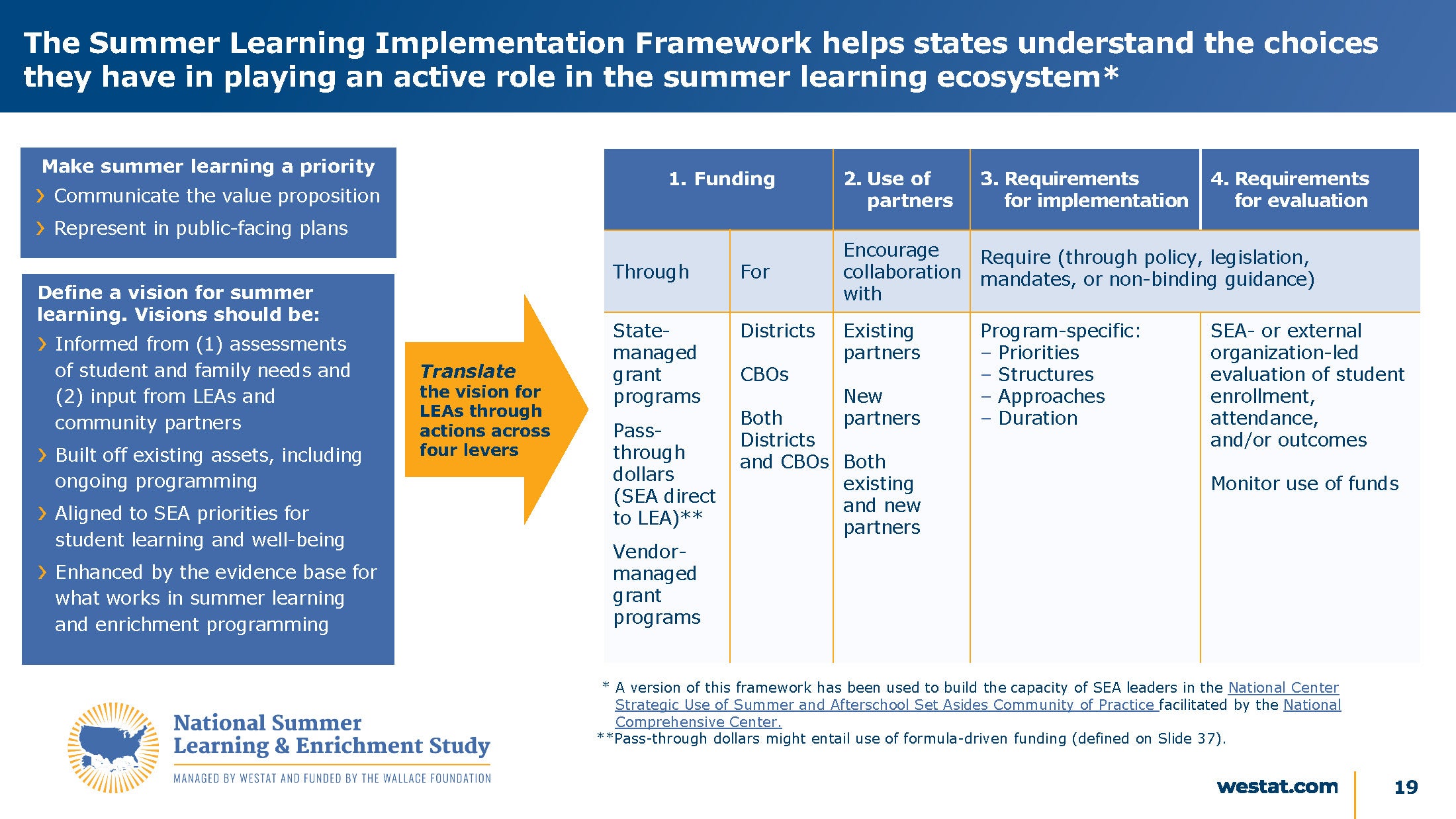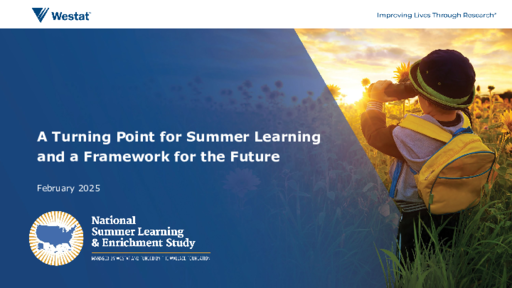Breadcrumb
- Wallace
- Reports
- A Turning Point For Summer Learn...
A Turning Point for Summer Learning and a Framework for the Future

- Author(s)
- Allison Crean Davis, John Hitchcock, Kristen Pugh, and Molly Hershey-Arista
- Publisher(s)
- Westat
Summary
How we did this
A post-pandemic call to action coupled with unprecedented resources created a turning point for summer learning in 2021. Drawing on multiple data sources, this study focused on state education agencies and districts, seeking to understand the scale and scope of summer 2021 programming, the policy decisions that shaped implementation, and lessons for the future.
Summary
A federal call to action in Spring 2021 asked school districts and state education agencies to address pandemic-related learning loss with high quality summer programming. Unprecedented federal funding through the American Rescue Plan (ARP) supported this call. The result? 94 percent conducted some type of summer learning programming in 2021. Each district served 18 percent of students. And, for the first time, state education agencies (SEAs) emerged as key players in summer learning.
This report is the third and final part of The National Summer and Learning and Enrichment Study (NSLES), which examines Summer 2021 from the perspective of state education agencies and school districts. It draws on a nationally representative survey of districts, interviews with local and state education officials, and qualitative and quantitative analysis of state ARP plans. Study findings provide a national snapshot of 2021 summer learning and identify the factors that influenced programming, with a special focus on state-level actions. They also provide a framework for improving the effectiveness of summer learning going forward.
Summer 2021 as turning point
Advancing student learning is challenging. Summer learning and enrichment programming is an evidence-based approach that can help. To do this programs must be well-designed, well-attended, and supported by high quality instruction.
Before 2021, decisions about summer learning programming were generally made by school districts and other local providers. Federal support was limited. State education agencies typically did not play a significant role in the planning, design, or provision of summer learning.
The $1.2b American Rescue Plan changed this. ARP required SEAs to allocate no less than 90% of ARP funds to school districts, with 1% reserved for summer learning. ARP required SEAs to submit public plans outlining how funds would be used.
Analysis of state ARP plans and interviews with state officials revealed how state actions could affect districts’ programs. Researchers identified several key SEA decision points that shaped district programming, including:
- Whether or not states chose to prioritize summer learning
- If and how states crafted a state-wide vision for summer learning
- How states translated their vision into action using four main levers:
- Funding. How should funds be allocated to LEAs and/or other providers, like community-based organizations?
- Partnerships. Should LEAs be required to work with partners?
- Implementation. Do LEAs have sufficient guidance that will enable them to design and implement high-quality programs in ways that align with the state’s vision?
- Evaluation. Do LEAs have sufficient guidance that will enable them to evaluate whether programs are contributing to positive outcomes?
Researchers developed a Summer Learning Implementation Framework based on these decision points. This framework can facilitate a better understanding of how SEA actions influenced summer 2021 programming. The framework can also help states understand the choices they have in playing an active role in the summer learning ecosystem going forward.
Examples of State Action
Creating a vision. School districts reported multiple benefits of their SEAs developing a statewide vision for summer learning. A statewide vision helped districts consider broader possibilities for summer learning, informed goal-setting for LEAs with little summer learning experience, and provided a clear value proposition and evidence base for summer learning for districts to communicate its value to families and students.
Program Funding. One state required school districts to include program innovation or expansion, evidence-based design, and engage local community partners in their grant applications. This led two school districts to offer new summer learning experiences including: launching a program to acclimate preschoolers to kindergarten; and, expanding programming to address a myriad of needs among vulnerable students, such as English Language Learners.

States made a difference in their new role and influenced how summer learning rolled out in 2021 at local levels. This shows how summer can be scaled and sustained in the future, but it will require collaboration and collective action.
Key Takeaways
- More than 90% of school districts provided some type of summer learning programming in Summer 2021, with the majority focused on academic programming. On average, districts served nearly 20% of their students.
- 80% of state education agencies made 2021 summer learning a clear priority in using their American Rescue Plan funds.
- Of state agencies interviewed, more than 80% developed a vision for summer learning and enrichment. States drew on assessments of student and family needs, school district and community partner input, existing assets, state priorities, and the summer learning research and evidence base to develop their visions.
- States generally approached their new role with summer learning by making it a priority, setting a vision, and deploying policy levers around funding, partnering, implementation, and evaluation.
- Students continue to have massive needs. The evidence suggests that quality summer programming could help address them. Although American Rescue Plans have sunset, there are other ways to fund summer programming that can be accessed and deployed.
Visualizations

Materials & Downloads
What We Don’t Know
- How can states continue to prioritize summer learning going forward?
- How can states’ greater involvement in summer learning affect the quality of summer learning programming, as experienced by participating students?



